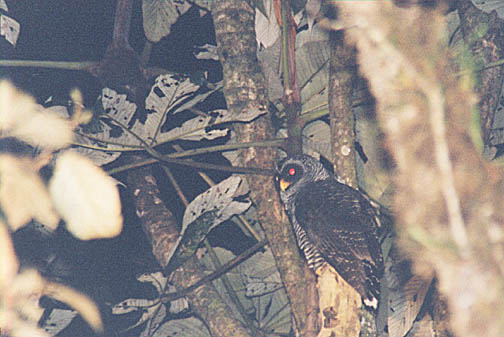|
Unknown Owl (Strix or Ciccaba
sp.)*
- 7 photos
|
 |

|
| 1 |
July 2002. Cabanas San
Isidro, Ecuador.
|
|

|
| 2 |
July 2002. Cabanas San
Isidro, Ecuador.
|
|

|
| 3 |
July 2002. Cabanas San
Isidro, Ecuador.
|
|

|
| 4 |
July 2002. Cabanas San
Isidro, Ecuador.
|
|

|
| 5 |
July 2002. Cabanas San
Isidro, Ecuador.
|
|

|
| 6 |
July 2002. Cabanas San
Isidro, Ecuador. © Sue Wright.
|
|

|
| 7 |
July 2002. Cabanas San
Isidro, Ecuador. © Sue Wright.
|
* This owl is currently a mystery to all professional
ornithologists in Ecuador, and elsewhere. Most agree that it looks intermediate
between a Black-and-white Owl (Strix nigrolineata) and a Black-banded Owl
(Strix huhula), and that it looks more like Black-banded. Note that the
bird does not show the solid blackish crown and nape that you would expect in
Black-and-white Owl, and that the barring on the underparts appears
intermediate.
But, here's where the mystery gets more interesting!
This bird occurs at Cabanas San Isidro, an eco-lodge at about 7500 feet
elevation on the east slope of the Andes. Black-and-white Owl is known in South
America only from the Pacific coastal lowlands of Colombia and Ecuador,
occurring no higher in elevation than about 2000 feet. So, this mystery owl is a
long distance from any Black-and-white Owls. Black-banded Owls do occur in the
Oriente of Ecuador, but again it is a lowland species, occurring no higher in
elevation than about 2000 feet. The mystery owls respond to tapes of
Rufous-banded Owl (Strix albitarsus), and drive off individuals of that
species at every opportunity. The vocalization of the mystery owl is more like a
Rufous-banded or Black-banded, and is nothing like the distinctive vocalization
of Black-and-white Owl.
Mitch Lysinger, who is one of Ecuador's top bird
guides, co-operates the lodge with his wife Carmen Bustamante, where these owls
occur. They have not yet collected any feathers or specimens. The owl remains a
mystery until it can be found, and collected, at some other site. Opinions have
varied on what this mystery owl actually is. Some feel it could be a previously
undocumented range and elevational extension for Black-banded Owl, but the
barring on the underparts, wings, and tail, is actually somewhat intermediate
between Black-banded and Black-and-white Owls. The issue of a hybrid between
Black-and-white and Black-banded Owls needs to be considered, but it seems
difficult to imagine that individuals from such widely separated geographic
areas could ever get together to hybridize. Also, there is a breeding pair of
these birds, which have raised two sets of young (probably more by now), and the
appearance of all birds is consistent, so a hybrid seems quite unlikely. The
possibility that this could be an undescribed subspecies of Black-banded Owl has
been considered, and others
feel this could be an undescribed new species.




